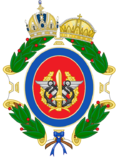Armed Forces of Karnia-Ruthenia
| Imperial and Royal Armed Forces | |
|---|---|
 Armed forces coat of arms | |
 Armed forces flag | |
| Founded | 26 November 2014 |
| Current form | 10 March 2016 |
| Service branches | Army Navy Aviation Troops |
| Leadership | |
| Commander-in-Chief | Emperor-King Oscar |
| Minister of War | Nicholas, Duke of Bradamante |
| Chief of Staff | Christian I, Grand Duke of Letzembourg |
The Imperial and Royal Armed Forces of Karnia-Ruthenia comprises the Armed Forces, the Ministry of War and the Secret Service of Karnia-Ruthenia serve as one of the Empire's core unifying institutions and primary instruments for defence as well as external power projection. The history of the Imperial and Royal military of Karnia-Ruthenia begins with the creation of the Armed Forces of the Kingdom of Ruthenia and its creation was determined by the signature of the Karno-Ruthenian Compromise of 2016.
The military system of Karnia-Ruthenia, based upon the principle of the universal and personal obligation of the citizen to protect his homeland. Its military force was composed of the Imperial and Royal Army, a Imperial and Royal Navy and a Imperial and Royal Aviation Troops. The common army stood under the administration of the joint Minister of War. The common Minister of War was the head for the administration of all military affairs and for all questions related to national defence of the states members of the Empire, but the supreme command of the army is vested in the monarch, who had the power to take all measures regarding the whole army and Commander-in-Chief.
History
Establishment
The Imperial and Royal Armed Forces was founded on 26 November 2014 as the Armed Forces of Ruthenia, few days after the foundation of the Kingdom of Ruthenia. The armed forces was originally, and still have very much of its primary function, intended to be a defensive force to protect the micronation. During this period, Ruthenia avoided major conflicts between 2014 and 2015 but engaged in a number of minor actions supported by the military, for example the 2015 Ruthenian coup d'état attempt and the Overthrow of the Badakistani monarchy.
Karno-Ruthenian Compromise of 2016
Following the signature of the Karno-Ruthenian Compromise of 2016, the armed forces were readapted and entire hierarchy, nomenclature and training program were reconsidered. They use the Austro-Hungarian model to make patents and the army hierarchy. With the formation of a better organized General Staff of the Armed Forces, there was also a profound change in the attitude of the military, who have adopted a more interventionist attitude towards the military policies of the Empire. The best example of this is intervention in the Lundener Civil War.
Army
The Karno-Ruthenian Army is the ground forces of the Armed Forces and is dedicated to the protection of Karno-Ruthenian interests within its territory or abroad.
The Karno-Ruthenian Navy is mainly a defence force dedicated to the protection of Karno-Ruthenian interests in Gurguéia River, a river which is the natural border of the Principality of St. Peter and St. Paul and crosses the Principality of St. Stephen, which also forms the Lake of Dead River (Lago do Rio Morto, in Portuguese).
Aviation Troops
The Imperial and Royal Aviation Troops was founded on 26 November 2014 as a defensive force to protect the micronation. However, it was disbanded on 8 March 2015 by the Royal Decree 019/2015. Following the signature of the Karno-Ruthenian Compromise of 2016, an air force was required by the Karnian signatories and having this term being accepted by the Ruthenians, the armed forces were readapted and entire hierarchy, nomenclature and training program were reconsidered. They use the Austro-Hungarian model to make patents and the army hierarchy, including the air force, now called as "Aviation Troops".